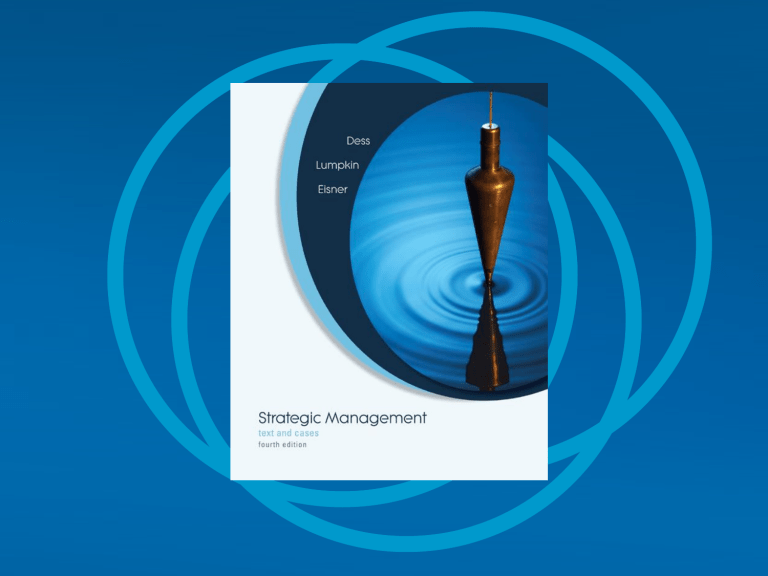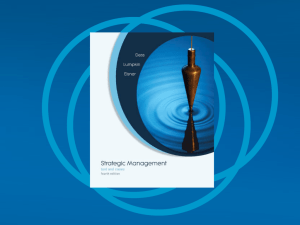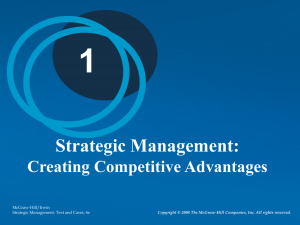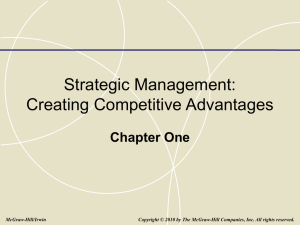Strategic Management: Competitive Advantage Presentation
advertisement

1 Strategic Management: Creating Competitive Advantages McGraw-Hill/Irwin Strategic Management: Text and Cases, 4e Copyright © 2008 The McGraw-Hill Companies, Inc. All rights reserved. 1-3 Two Perspectives of Leadership • Romantic view ‾ • Leader is the key force in organization’s success External control perspective ‾ • Focus is on external factors that affect an organization’s success Leaders can make a difference ‾ ‾ Must be aware of opportunities and threats faced in external environment Must have thorough understanding of the firm’s resources and capabilities 1-4 Strategic Management • Analysis ‾ Strategic goals (vision, mission, strategic objectives) ‾ Internal and external environment of the firm • Strategic decisions ‾ What industries should we compete in? ‾ How should we compete in those industries? • Actions ‾ Allocate necessary resources ‾ Design the organization to bring intended strategies to reality 1-5 Strategic Management • Strategic management is the study of why some firms outperform others ‾ How to compete in order to create competitive advantages in the marketplace ‾ How to create competitive advantages in the market place o Unique and valuable o Difficult for competitors to copy or substitute • Characteristics of strategic decisions… - Important - Involve a significant commitment of resources - Not easily reversible 1-6 Key Attributes 4 Key Attributes of strategic management: • • • • Directs the organization toward overall goals and objectives Includes multiple stakeholders in decision making Needs to incorporate short-term and long-term perspectives Recognizes trade-offs between efficiency and effectiveness 1-7 Question • The final realized strategy of a firm is a combination of: a) b) c) d) Intended and unrealized strategies Unrealized and emergent strategies Emergent and deliberate strategies Deliberate and unrealized strategies 1-8 Strategic Management Process for Intended Strategies Missions and Goals External Analysis Strategic Choice INTENDED STRATEGY Organizing for Implementation Internal Analysis 1-9 Strategic Management Process Adapted from Exhibit 1.2 Realized Strategy and Intended Strategy: Usually Not the Same Source: H. Mintzberg and J. A. Waters, “Of Strategies, Deliberate and Emergent,” Strategic Management Journal 6 (1985), pp. 25772. 1 - 10 Strategic Management Process for Emergent Strategies External Analysis Missions and Goals Strategic Choice Does It Fit? EMERGENT STRATEGY Organizational Grassroots Internal Analysis 1 - 11 Strategic Analysis • Starting point in the strategic management process • Precedes effective formulation and implementation of strategies 1 - 12 Strategic Analysis (cont.) • Clear goals and objectives permit effective allocation of resources • Hierarchy of goals - Vision - Mission - Strategic objectives • Analyzing external environments - Managers must scan the environment and analyze competitors - General environment - Industry environment 1 - 13 Strategic Analysis (cont.) • Frameworks for analyzing a firm’s internal environment - Strengths - Weaknesses • Analyzing strengths can uncover potential sources of competitive advantage 1 - 14 Strategic Analysis (cont.) • Intellectual assets are drivers of - Competitive advantage - Wealth creation • Networks and relationships among - Employees Customers Suppliers Alliance partners 1 - 15 Strategy Formulation • Business level strategy: - Successful firms develop bases for competitive advantage • Cost leadership • Differentiation • Focusing on narrow or industry-wide market segments - Sustainability - Industry life cycle 1 - 16 Strategy Formulation (cont.) Corporate-level strategy addresses: • Firm’s portfolio or group of businesses - What business(es) should we be in? - How can we create synergies among the businesses? • Diversification - Related - Unrelated 1 - 17 Strategy Formulation (cont.) • International Strategy - Appropriate entry strategies for foreign markets - Sustain competitive advantage in global markets • Effective strategies for entrepreneurial initiatives 1 - 18 Strategy Implementation • Informational control - Monitor and scan the environment - Respond effectively to threats and opportunities • Behavioral control • Effective corporate governance - Interests of managers and owners of the firm • Organizational structure and design 1 - 19 Strategy Implementation (cont.) • Organizational boundaries - Flexible - Permeable • Strategic Alliances • Develop organization that is committed to - Excellence - Ethical behavior 1 - 20 Strategy Implementation (cont.) • Learning organization responsive to - Rapid and unpredictable change • Corporate entrepreneurship and innovation - New opportunities Enhance innovative capacity Autonomous entrepreneurial behavior Product champions 1 - 21 Corporate Governance and Stakeholder Management • Corporate governance: the relationship among various participants in determining the direction and performance of corporations - Shareholders - Management (led by the CEO) - Board of Directors 1 - 22 Corporate Governance and Stakeholder Management (cont.) • Board of Directors - Elected representatives of the owners - Ensure interests and motives of management are aligned with those of the owners • Effective and engaged Board of Directors • Shareholder activism • Proper managerial rewards and incentives 1 - 23 Example: New Rules for Directors In light of numerous corporate scandals, the role and rules for board of directors are being redefined. Few areas of focus : - Numbers Knowledge Strategy Focus Time & Understanding Watchdog Source: Tipsheet, Business Week, January 22, 2007 1 - 24 Stakeholder Management • Two views of stakeholder management - Zero sum • Stakeholders compete for attention and resources of the organization • Gain of one is a loss to the other - Symbiosis • Stakeholders are dependent upon each other • Mutual benefits 1 - 25 Social Responsibility • Social responsibility: the expectation that businesses or individuals will strive to improve the overall welfare of society ‾ Managers must take active steps to make society better ‾ Socially responsible behavior changes over time ‾ Triple bottom line 1 - 26 Example: Social Responsibility Starbucks Coffee Company Corporate social responsibility is embedded throughout the organization. The following are some of the commitments they have made to be socially responsible: • • • • Commitment to origins Helping protect the environment Starbucks in your community Commitment to partners Source: www.starbucks.com 1 - 27 Example: Social Responsibility •Johnson & Johnson’s credo sets its responsibilities to: 1. J&J product users. 2. J&J employees. 3. Communities in which J&J employees live and work. 4. J&J stockholders. Source: Courtesy of Johnson & Johnson. 1 - 28 Strategic Management Perspective • Integrative view of the organization • Assess how functional areas and activities “fit together” to achieve goals and objectives • All managers and employees must take and integrative, strategic perspective of issues facing the organization 1 - 29 Coherence in Strategic Direction • Company vision - Massively inspiring Overarching Long-term Driven by and evokes passion - Fundamental statement of the organization’s • Values • Aspiration • Goals Company vision Hierarchy of Goals 1 - 30 Coherence in Strategic Direction • Mission statements - Purpose of the company - Basis of competition and competitive advantages - More specific than vision - Focused on the means by which the firm will compete Company vision Mission statements Hierarchy of Goals 1 - 31 Coherence in Strategic Direction • Strategic objectives - Operationalize the mission statement - Provide guidance on how the organization can fulfill or move toward the “higher goals” - More specific - Cover a more well-defined time frame Company vision Mission statements Strategic objectives Hierarchy of Goals 1 - 32 Coherence in Strategic Direction • Strategic objectives - Measurable Specific Appropriate Realistic Timely Challenging Resolve conflicts that arise Yardstick for rewards and incentives Company vision Mission statements Strategic objectives Hierarchy of Goals




